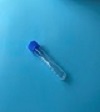Lyme central nervous system infection IgG with antibody index reflex, serum and spinal fluid
Lyme central nervous system infection IgG with antibody index reflex, serum and spinal fluid-15962
Lyme serology, CSF
Neuroinvasive Lyme Disease
Neuroborreliosis
Lyme Disease in the Central Nervous System
Lyme CNS Disease
Aiding in the diagnosis of neuroinvasive Lyme disease or neuroborreliosis due to Borrelia species associated with Lyme disease (eg, B burgdorferi, B garinii, B afzelli)
- This test should be ordered in patients with suspected neuroinvasive Lyme disease.
- Although a small percentage of patients with neuroinvasive Lyme disease may be seronegative, it is recommended that all patients test by the Lyme Antibody Index assay also have standard 2-tiered testing for Lyme disease performed on serum.
- This test compares the level of IgG antibodies to Lyme disease-causing Borrelia species in spinal fluid (CSF) and serum. The level of anti-Borrelia species IgG is normalized to total IgG and albumin in CSF and serum.
- This test can help identify whether the presence of IgG to Borrelia species in the CSF is due to true intrathecal antibody synthesis, suggesting neuroinvasive Lyme disease, versus antibody presence due to passive diffusion through the blood-brain barrier or possibly, due to blood contamination of the CSF as a result of a traumatic lumbar puncture
Serum - 1.5 mL
Serum - 1.2 mL
Spinal fluid (CSF)
- A spinal fluid sample of 1.5 mL needs to be collected within 24 hours of the serum specimen, preferably at the same time
- Label vial as spinal fluid or CSF
- CSF aliquot should be from the second, third, or fourth CSF vial collected during the lumbar puncture.
- Do not submit CSF from the first vial due to the possibility of blood contamination, which will cause specimen rejection.
Serum:
- A serum sample needs to be collected within 24 hours of the spinal fluid specimen, preferably at the same time
- Immediately following collection, thoroughly mix sample by gently inverting 5 times
Gold serum separator (SST) tube:
- Allow sample to clot for a minimum of 30 minutes
- Spin within two (2) hours of sample collection
Following centrifucation of the SST tube, rubberband the CSF vial and SST tubes together.
Sterile vial and Gold serum separator (SST) tube
- Allow sample to clot for a minimum of 30 minutes
- Spin within two (2) hours of sample collection
- Transfer serum to a Screw cap transfer vial/tube (Mayo T914), labelled as serum
Once the serum is transferred to a Screw cap transfer vial/tube (Mayo T465), rubberband the CSF and serum transfer vials together.
Refrigerated (preferred) - 11 days
Frozen - 35 days
Serum:
- Gross hemolysis
- Gross lipemia
CSF:
- Contaminated with blood
Enzyme-Linked Immunosorbent Assay (ELISA)
Negative
Negative:
No antibodies to Lyme disease causing Borrelia species detected in spinal fluid. A negative result in a patient with appropriate exposure history and symptoms consistent with neuroinvasive Lyme disease should not be used to exclude infection. Testing for antibodies to Lyme disease-causing Borrelia species in serum should be performed.
Reactive:
Supplemental testing to determine a Lyme central nervous system antibody index has been ordered. Diagnosis of neuroinvasive Lyme disease should not be established solely based on a reactive screening result.
Additional CPT codes (If applicable):86618 x 2
82040
82042
82784 x 2


